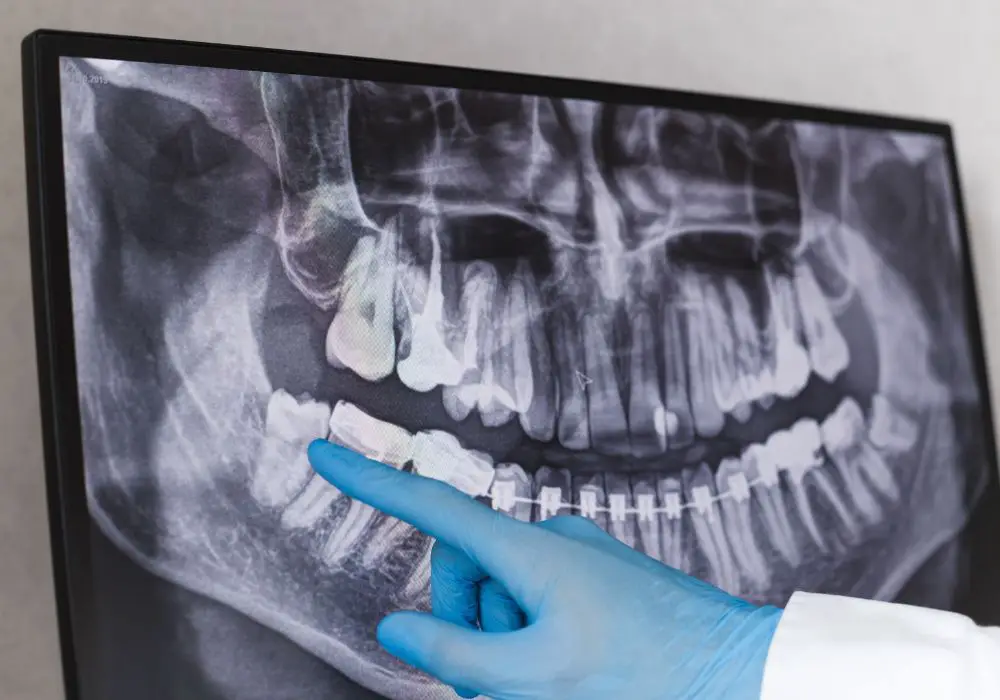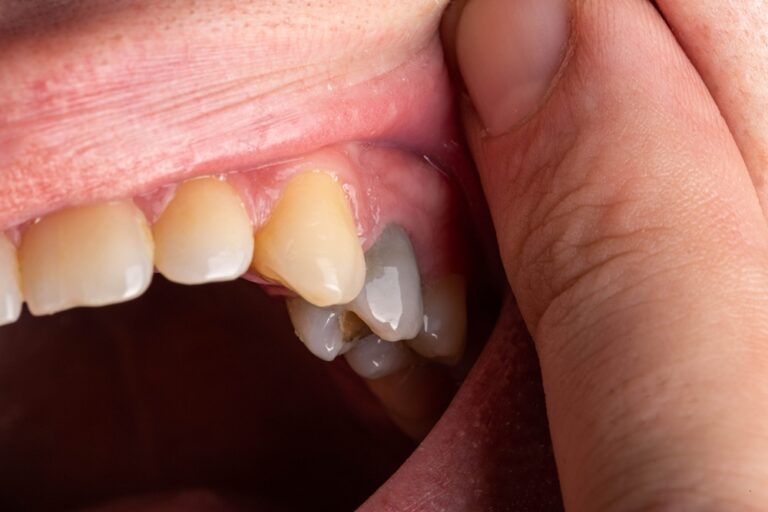Understanding Wisdom Teeth and Their Potential for Pain

Wisdom teeth, also known as third molars, are the last set of molars to erupt, typically between the ages of 17 and 25. They are located at the very back of your mouth and often become impacted or only partially emerge due to lack of space.
Wisdom teeth start to form and develop below the gums during the preteen years. The crown of the wisdom tooth forms first, followed by the root during the teen years. Impacted wisdom teeth have developed in a problematic position where there is not enough room in the jaw or mouth for them to fully emerge through the gums. They may be tilted at an angle, remain trapped under gum tissue, or only partially erupt.
When wisdom teeth become impacted or only partially erupt, it can cause pain, swelling, infection, cysts, and damage to nearby teeth and bone. This is because the tooth is trying to push through tissue and bone where there may not be enough room. As the wisdom tooth attempts to break through the gums and crowd into position, it puts pressure on surrounding nerves, tissue, and other teeth. This leads to inflammation and friction, which causes the pain symptoms.
Common signs and symptoms of problematic wisdom teeth include:
- Pain or soreness around the jaw, ears, or back molars
- Redness, swelling, and tenderness of the gums around the wisdom tooth
- Headaches or jaw pain when chewing or biting down
- Bad breath, unpleasant taste in the mouth
- Difficulty opening the mouth fully
- Food getting trapped around the wisdom tooth area
- Swollen lymph nodes under the jaw and neck
The pain from wisdom teeth can range from mild discomfort to severe, throbbing pain that disrupts sleep and daily activities. The level of pain depends on how problematic the wisdom tooth is:
- A wisdom tooth just starting to break through the gums may cause mild soreness and sensitivity when eating or brushing teeth.
- A partially impacted wisdom tooth may lead to gum inflammation, swelling, ear pain, and throbbing discomfort that comes and goes.
- A fully impacted wisdom tooth with infection can cause severe, radiating pain along the jaw, bad breath, swollen lymph nodes, and pain that keeps you awake at night.
How Long Can You Leave Wisdom Tooth Pain Untreated?

It is not recommended to leave wisdom tooth pain untreated for an extended period of time. Here is how long you can reasonably wait with mild, moderate, and severe wisdom tooth pain symptoms before seeking professional treatment:
Mild Wisdom Tooth Pain
If you have mild wisdom tooth pain that comes and goes, you can monitor it for 1-2 weeks to see if the symptoms resolve on their own as the tooth continues to erupt.
However, if the pain has persisted for more than 2 weeks with no improvement, it’s time to see a dentist. The pain is a sign that the emerging wisdom tooth needs to be extracted before it crowds other teeth or leads to worsened impaction.
Use over-the-counter pain medication as needed for relief. Keep the area clean by gently rinsing with saltwater. See a dentist promptly if the pain worsens or swelling develops.
Moderate Wisdom Tooth Pain
For constant, throbbing wisdom tooth pain that disrupts sleep or daily activities, you should see a dentist within 1-2 days. The constant pain likely indicates an infection or cyst has developed around the wisdom tooth root. This requires antibiotics and removal.
Use OTC pain medication around the clock to manage the pain until you can be seen. Rinse with warm salt water and keep the area clean. Seek emergency dental care if you develop swelling spreading into the neck, fever over 101F, or difficulty swallowing. These are signs the infection is progressing rapidly.
Severe Wisdom Tooth Pain
With severe, excruciating wisdom tooth pain, especially if accompanied by swelling, fever, or difficulty opening your mouth, you should seek emergency dental care right away.
Severe infections require antibiotics and urgent wisdom tooth removal. The infection can quickly spread from surrounding tissue into the jawbone, other teeth roots, neck and throat area if left untreated. Seek emergency medical care if breathing becomes impaired.
Use OTC pain relievers as needed until you can be seen. Keep taking any prescribed antibiotics to help slow the infection spreading. However, only removing the infected wisdom tooth can fully resolve the problem.
Dangers of Leaving Wisdom Tooth Pain Untreated

While mild or moderate wisdom tooth pain may be tolerable for a short period, leaving it untreated for too long has risks including:
- Infection spreading – Bacterial infections can start locally around the wisdom tooth and spread deeper into gum tissue, jaw bone, nearby teeth, throat, or neck if left untreated.
- Cysts or abscesses – Fluid-filled sacs called cysts can form around the wisdom tooth root. Abscesses are pus-filled infections. Cysts and abscesses won’t go away without treatment and surgery to remove the problem tooth.
- Damage to other teeth – Wisdom teeth pushing into adjacent teeth can loosen them, expose them to infection, or cause tooth decay over time. This can lead to loss of previously healthy teeth.
- Nerve damage – Wisdom teeth putting pressure on or getting too close to nerves can initially cause numbness or tingling, but lead to permanent altered sensation or nerve injury if left untreated. This can affect the lip, chin, or tongue.
- Difficult extractions – Allowing wisdom teeth to become deeply impacted makes the eventual extraction more complicated. It may require cutting into bone and removing portions of the jaw bone if infection spreads there. This delays healing.
- Systemic infection – While extremely rare, severe infections left untreated may spread systemically through the bloodstream and become life-threatening. Seek emergency care for breathing problems, high fever, or confusion.
Prolonged pain is also disruptive to sleep, work, relationships and overall quality of life. Wisdom tooth removal may be inevitable, so it’s best to address the pain and have extraction surgery promptly before more problems arise.
Wisdom Tooth Pain Management Options
While waiting to have problematic wisdom teeth surgically removed, there are some pain management remedies you can try at home in addition to over-the-counter medication:
- Cold compresses – Applying an ice pack or cold compress to the outside of your cheek near the wisdom tooth helps reduce inflammation and dull pain signals. Use for 10-15 minutes at a time, taking breaks to avoid damaging tissue.
- Warm compresses – Alternatively, holding a warm washcloth against your cheek can help increase blood flow and soothe discomfort after the first 1-2 days when swelling has stabilized.
- Salt water rinses – Gently swishing and rinsing with warm salt water 2-3 times a day keeps the area clean and may ease pain by drawing out fluid buildup in tissues.
- Soft foods – Stick to soft foods like soup, apple sauce, and mashed potatoes. Avoid hard, crunchy, or chewy foods that put pressure on the problematic wisdom teeth while eating.
- Dental numbing gel – Products like Orajel contain numbing agents like benzocaine to temporarily dull wisdom tooth pain and discomfort. Apply as directed for short term relief.
- Clove oil – Applying a small amount of clove oil directly on the gums around the painful wisdom tooth may temporarily reduce inflammation and pain signals.
- Guided relaxation – Stress and tension can make wisdom tooth pain feel more intense. Try guided meditation, deep breathing, progressive muscle relaxation, or hypnosis techniques to help manage the discomfort.
While these remedies may temporarily ease symptoms, the only way to resolve problematic wisdom teeth is to have them extracted by an oral surgeon. Seek prompt dental care rather than waiting if pain is severe or persists longer than 1-2 weeks. Getting ahead of complications will lead to faster relief and an easier recovery.
Professional Treatment Options for Wisdom Tooth Pain

Here are the typical professional treatment options for managing problematic, painful wisdom teeth:
Dental Exam and X-rays
If wisdom tooth pain develops, it’s important to have the teeth and surrounding area examined and imaged. The dentist will check for signs of infection and take panoramic x-rays to determine the position of the wisdom teeth and how impacted they are. This informs the proper treatment approach.
Antibiotics for Infections
If there are signs of infection like swelling, redness, fever or swollen lymph nodes, the dentist may prescribe a course of antibiotics. Penicillin or clindamycin are commonly used to treat wisdom tooth infections. The medication helps clear infection and reduce pain prior to wisdom tooth extraction.
Wisdom Tooth Extraction
Surgically removing impacted, partially erupted, or infected wisdom teeth is the only permanent way to resolve associated pain and complications. The oral surgeon will numb the area with local anesthetic before removing the problematic teeth. Wisdom tooth extraction is very common, with over 5 million done annually in the United States.
Follow-up Care
Following wisdom tooth extraction, you’ll need to keep the area clean while it heals over the next week or so. The surgeon prescribes pain medication, usually ibuprofen and acetaminophen alternating, to keep you comfortable as you recover. Antibiotics may also be prescribed. Follow all post-care instructions carefully to prevent complications.
Seeking professional dental care quickly for wisdom tooth pain allows early treatment of any infection and timely removal of the problematic teeth before more extensive problems develop. Don’t delay in addressing prolonged wisdom tooth pain.
Wisdom Tooth Pain FQA
1. Is it normal for wisdom teeth to hurt when they first come in?
It is common to have some mild pain and discomfort as wisdom teeth start pushing through the gums and the surrounding tissue and bone. This is the body’s inflammatory response to the erupting tooth. Severe, throbbing pain that disrupts sleep is not a normal part of teething and indicates a problem.
2. How can you tell if wisdom tooth pain is from an infection that requires antibiotics?
Signs the pain is due to a bacterial infection requiring antibiotics include swelling spreading into the neck or jaw, redness and heat around the tooth, swollen lymph nodes, foul taste or breath odor, fever or chills, and severe constant throbbing pain that keeps worsening.
3. What happens if you leave a wisdom tooth infection untreated for a long time?
An untreated wisdom tooth infection can eventually worsen and spread from the tooth to the jawbone, nearby teeth roots, gum tissue, sinuses, or neck. It can perforate through tissue and the skin may rupture to release pus. Very rarely, a severe infection may spread into the bloodstream becoming life-threatening.
4. Can wisdom tooth pain come and go over time?
Yes, it is common for wisdom tooth pain or discomfort to flare up for a period of time, then seem to subside for a while before flaring up again. The onset of pain is often a sign of inflammation around a tooth that is newly impacting or becoming infected. The pain may die down as the infection temporarily drains, but prolongued pain indicates surgical removal is inevitable.
5. How long does wisdom tooth pain last after extraction?
It is normal to have some residual mild pain, swelling, and discomfort for around 1 week after having a wisdom tooth extracted as the area heals. The worst pain is usually on days 2 and 3. Using ice packs and taking prescribed pain medication helps manage this post-operative discomfort. Call your oral surgeon if severe throbbing pain persists beyond a week.
Conclusion
In summary, it is recommended not to wait more than 1-2 weeks to address ongoing wisdom tooth pain. See a dentist right away if the pain becomes severe or is accompanied by fever or swelling. Attempting to live with the pain long term can allow infections to worsen and cause serious complications. Getting problematic wisdom teeth removed promptly leads to the quickest resolution of pain and prevention of future dental issues.







